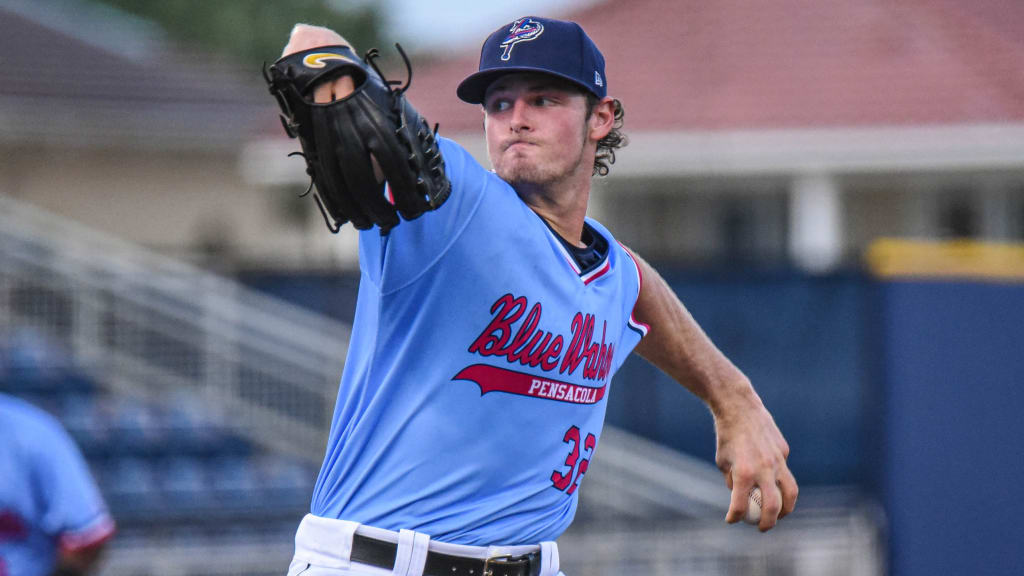
Jake Eder believes in what he calls “moments of truth.” These are the instances where something either happens or it doesn’t. More specifically, he makes that thing happen, or he doesn’t.
As his first Spring Training with the Marlins was winding down, the left-hander first saw his name on the High-A Beloit roster. What followed was a moment of truth.
“I had a lot of confidence in what I was doing,” said the 2020 fourth-rounder out of Vanderbilt. “When I knew that, other people start to know too, and it solidifies their sense of knowing. I would say it was me knowing with absolute certainty that I was ready to go to The Show. So they felt that, I guess, and sent me to Pensacola.”
Pensacola is Miami’s Double-A affiliate. Only five members of the 2020 Draft class opened this season in Double-A or above. Garrett Crochet moved back to the Majors after making his debut last year. Reid Detmers, Max Meyer and Austin Martin, all at Double-A, were first-round picks.
Then, there was Eder, the 104th overall selection, and you can see why it looks like the Marlins southpaw was an outlier from the beginning.
Entering Thursday, Eder leads all qualified Minor Leaguers with a 1.03 ERA through 52 2/3 innings with the Blue Wahoos. His 2.18 FIP is fourth-best among the 242 qualifiers, while his 0.91 WHIP, 76 strikeouts and 36.2 percent strikeout rate rank third at Double-A. On Sunday, the No. 22 prospect in the Marlins' system will head to the SiriusXM All-Star Futures Game alongside Meyer as one of Miami’s two representatives.
The baseball world is taking notice. So was this a dominant pitcher everyone missed in the first three-plus rounds of the 2020 Draft or is it a case of a legitimate breakout coming in a prospect’s first taste of the Minors? For now, it feels like the latter.
Evaluators didn’t know what to make of Eder heading into the shortened five-round Draft, and that included those that eventually took him. Miami had seen the left-hander -- a potential high 2017 pick if not for his strong commitment to Vanderbilt due to a low-90s fastball and promising breaking ball -- struggle with control as a freshman, dominate when he was a reliever as a sophomore and be only decent in his brief return to starting in 2020. A good run in the Cape Cod League (1.20 ERA in four appearances) in the summer of 2019 only heightened the questions of who was the true Jake Eder.
“He was super inconsistent,” Marlins director of amateur scouting DJ Svihlik told reporters last month. “If you saw our Cape Cod reports, you’d go, ‘Wow, that’s a potential first-round pick.’ You see our Vanderbilt reports, [and it wasn’t there]. I was trying to balance all that stuff out.”
Miami bet on Eder’s highs by taking him in the fourth round. By late July, the two sides agreed to a $700,000 bonus, comfortably above the $560,000 assigned to that slot.
But an entry point wasn’t enough to get Eder over the hump. As he prepared for the rigors of pro ball, the southpaw became more intrigued about the mental aspects of baseball. He started to make connections with others around the sport and eventually got involved with a mental guide who he talks to often over the phone.
“I was not that guy in college," Eder said. "I didn't have a mental routine. I didn't have a mental plan. I didn't have a toolbox of mental adjustments that I brought out with me on the mound, which I do now. I'm continuing to improve on and hone those.”
In particular, the focus on his mental approach helped Eder fine-tune the command that had brought down his profile previously.
“When you simplify it, you want to be doing the exact same thing regardless of the count,” said the hurler. “So being able to take that mindset and land a 3-2 breaking ball for strike three, those kinds of things are what gets you out of big spots. Those are the moments of truth, where you have to execute. You either do, or you don't."
Marlins pitching coordinator Scott Aldred could notice quickly that Eder was on a different path than a typical fourth-rounder. The southpaw participated in last year’s fall instructional league, and by the time he arrived in spring, he looked like a pitcher whose ascent had carried through the winter. His fastball was sitting 93-96 and touching as high as 98. His breaking ball -- deemed by some a curveball, others (like Eder and Aldred) a slider -- featured plenty of depth and lateral break. Even the changeup, which Eder estimates he threw only five times in his three years at Vanderbilt, had developed into a mid-80s option that can have the bottom drop out of it.
"I felt like he could go out there and really perform well just based on his fastball-slider," Aldred said. "His willingness to throw the changeup was coming, and it still is doing well. The pitch is starting to come around.
“I felt like all along, from somewhere in February there, I wanted him in Double-A, but it was going to take some convincing others in the organization. It took a little work, but we got him there and it turns out that it's been a good move.”
Eder made Aldred and the staff’s decision look wise immediately. He struck out 12 batters over five, one-hit innings in his pro debut at Mississippi on May 6. Ever since, he's been doing a Jacob deGrom impression in Double-A.
"Take the talent that we saw, with his motivation, the creativity and work of our player-development staff," Svihlik told reporters, "and you get a player who looks like he’s outperforming his Draft position.”
The prospect showcase in Denver is the next moment of truth. He’ll either show the world he’s one of 2021’s breakout prospects or he won’t. If he can, it’ll be one step closer to the next big moment.
“My mindset going into Spring Training was I'm a big leaguer right now,” he said, “and everything else just hadn't caught up yet.”
